Cooking mushroom fused row
The preparation of the accreted row practically does not differ from the preparation of other species of this family. I must say that cleaning and soaking are carried out in the same way. Boiling the rows should be carried out in salted water with the addition of a pinch of citric acid for 20-30 minutes. After pretreatment, they can be fried, stewed, pickled or salted. Many culinary experts claim that in pickled and salted form, the accreted row has an amazing taste.
Only after reading in detail the description and photo of the accreted row (Lyophyllum connatum), you can decide whether it is poisonous or not. You can ask experienced mushroom pickers for advice, taste the cooked ryadovka and then make a final decision.
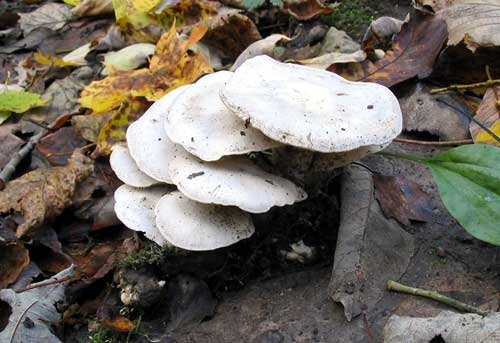
Description of the edible mushroom
The accreted row (Lyophyllum connatum - lat.) Belongs to the Lyophyll family. Previously, the fungus was identified to the genus Lyophyllum, and now - to Leucocybe. Another name is Lyophillum fused. Has a characteristic white color, grows together with legs and sometimes caps. Convex and hemispherical caps are inherent in young bodies; with aging, their edges become torn, and the structure is flat.
The diameter of the ryadovka cap reaches ten centimeters, and sometimes fifteen. When touched, the smoothness and velvety of the white body is felt, and during the rainy season, the shade turns into blue or olive gray. The edges of the cap are tucked down to help preserve the hymenium.
The lower part of the cap (hymenophore) is brownish. Rows grown together, like a cap mushroom, are of the lamellar type. The plates are called radial outgrowths, diverging from the stem to the cap of the fruiting body. Narrow and frequent plates sometimes grow with teeth.
The pulp is white in color and has a characteristic aroma that resembles cucumber. The texture is elastic.
The shape of the leg is flattened, sometimes cylindrical. Has a velvety surface. Reaches twelve centimeters in length. It consists of fibers, and after maturation forms a cavity, but does not change its snow-white color throughout the entire period of growth. When the legs are spliced, a common root of the fungus is formed.
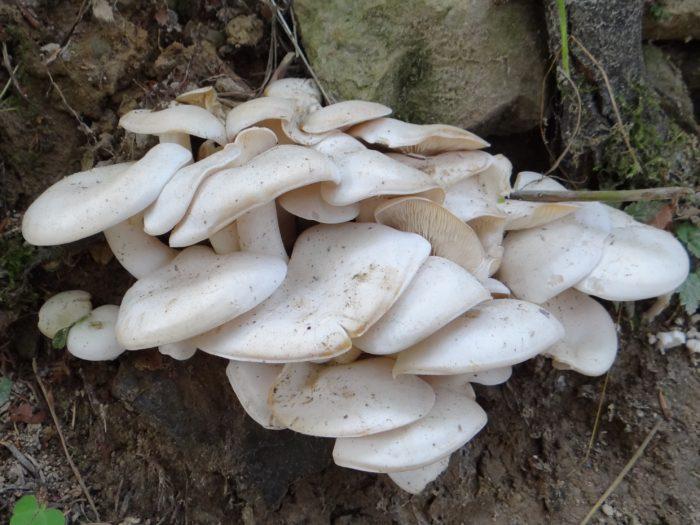
Primary processing and cooking recipes
Rows are eaten by both young and adults. They are suitable for all types of culinary processing: boiling, frying, pickling, salting. Soups are cooked from the fruit bodies and served with grilled meat, which gives the products a piquancy and aroma. After harvesting, the mushrooms are cleaned and sorted, then rinsed abundantly under running water to get rid of the remnants of dirt and grass. To preserve its bright taste, lyophyllum is soaked in ice water before cooking, then peel off the thin skin from the cap and boil for 15 minutes in water with the addition of vinegar. After boiling, the fruits are poured into a colander to get rid of excess liquid. If you need to remove the mealy smell, you need to boil them again by adding onions to the pan. The row is ready for cooking.
Fry lyophyllum in a hot frying pan with vegetable oil, stirring for 10 minutes. For taste, add salt and finely chopped onions.
Lyophillum shimeji
Hon-shimeji
Until recently, it was believed that Shimeji Lyophyllum (Lyophyllum shimeji) is distributed only in a limited area covering the pine forests of Japan and parts of the Far East. At the same time, there was a separate species, Lyophyllum fumosum (L. smoky gray), associated with forests, especially conifers, some sources even described it as a mycorrhizal forming agent with pine or spruce, outwardly very similar to L.decastes and L.shimeji. Recent molecular studies have shown that no such separate species exists, and all finds classified as L. fumosum are either L.decastes (more commonly) or L. shimeji (Lyophillum simeji) (less commonly, in pine forests). Thus, today (2018), the species L.fumosum has been abolished, and is considered a synonym for L.decastes, significantly expanding the habitat of the latter, almost to “anywhere”.Well, L.shimeji, as it turned out, grows not only in Japan and the Far East, but is widespread throughout the boreal zone from Scandinavia to Japan, and, in some places, is found in pine forests of the temperate climatic zone. It differs from L.decastes only in larger fruit bodies with thicker legs, growth in small aggregates or separately, binding to dry pine forests, and at the molecular level.
Description
Hat: 4 - 7 centimeters. In youth, it is convex, with a pronounced curved edge. With age it evens out, becomes slightly convex or practically spread, in the center of the cap, a pronounced wide, low tubercle is almost always preserved. The skin of the cap is slightly matte, smooth. The color range - in gray and brownish tones, from light grayish-brown to dirty gray, can acquire yellowish-gray shades. On the cap, dark hygrophane spots and radial stripes are often clearly distinguishable; sometimes, a small hygrophane pattern in the form of a "mesh" can be present.
Plates: frequent, narrow. Loose or slightly adherent. In young specimens, white, later darken to beige or grayish.
Leg: 3 - 5 centimeters in height and up to one and a half centimeters in diameter, cylindrical. White or grayish. The surface is smooth, can be silky or fibrous to the touch. In the growths formed by mushrooms, the legs are firmly attached to each other.
Ring, bedspread, volva: none.
Flesh: firm, white, slightly grayish in the stem, firm. Does not change color at cut and break.
Smell and taste: pleasant, slightly nutty taste.
Spore powder: white. Spores: round to broadly ellipsoid. Smooth, colorless, hyaline or with fine-grained intracellular content, weakly amyloid. With a large spread in size, 5.2 - 7.4 x 5.0 - 6.5 microns.
Season and distribution
Active fruiting occurs in August - September. Lyophyllum shimeji grows in small aggregates and groups, rarely singly. Distributed throughout Eurasia from the Japanese archipelago to Scandinavia.
Similar types and differences from them
Crowded lyophyllum (Lyophyllum decastes) also grows in aggregates, but these aggregates consist of a much larger amount of fruit chalk. Prefers deciduous forests. The fruiting period is from July to October. Lyophyllum elm (Oyster mushroom, Hypsizygus ulmarius) is also considered very similar in appearance due to the presence of hygrophane rounded spots on the cap. In oyster mushrooms, fruiting bodies with a more elongated stem and the color of the cap are generally lighter than in Lyophillum simeji
However, these external differences are not so fundamental if we pay attention to the environment. Oyster mushroom does not grow on soil, it grows exclusively on dead wood of deciduous trees: on stumps and wood residues immersed in the soil
Other information about the mushroom
The specific name "Shimeji" comes from the Japanese name for the species Hon-shimeji or Hon-shimejitake. But in fact, in Japan under the name "Shimeji" one can find on sale not only Lyophyllum shimeji, but also, for example, another lyophillum actively cultivated there, elm.
Mushroom photo Lyophillum shimeji from questions in recognition:
Interesting facts about the mushroom
- The growing row has been known to the world for almost 150 years.
- Lyophyllum is a quite memorable species, it is easy to distinguish it from poisonous congeners. Just study the photo, after that it will be easier to determine the fused row.
- Due to the fact that the row grows together with a leg, having found a mushroom clearing, you can immediately collect a full basket of harvest.
- This species is considered a delicacy in many countries.
- It lends itself to all basic cooking techniques, which allows you to taste the mushroom in a variety of variations.
- Edible row strengthens the immune system.
The growing row, although it is considered a conditionally edible mushroom, is nevertheless widely used both in cooking, and in medicine, cosmetology. To collect it, it is better to go to the forest or meadow, so as not to stumble upon toxic mushrooms. This must be borne in mind when collecting any kind of fruit chalk.
An excerpt characterizing Ryadovka accrete
On Friday, the Rostovs were supposed to go to the village, and on Wednesday the count went with the buyer to his Moscow region.
On the day the count left, Sonya and Natasha were invited to a big dinner at the Karagin's, and Marya Dmitrievna took them. At this dinner Natasha again met with Anatole, and Sonya noticed that Natasha was saying something to him, wishing not to be heard, and during the dinner she was even more agitated than before. When they returned home, Natasha began the first with Sonya the explanation that her friend had been waiting for.
- Here you, Sonya, said various nonsense about him, - Natasha began in a meek voice, the voice that children speak when they want to be praised. - We have explained to him today.
- Well, what, what? Well, what did he say? Natasha, how glad I am that you are not angry with me. Tell me everything, the whole truth. What did he say?
Natasha pondered.
- Oh Sonya, if you knew him as I do! He said ... He asked me how I promised Bolkonsky. He was glad that it was up to me to refuse him.
Sonya sighed sadly.
“But you didn't refuse Bolkonsky,” she said.
- Or maybe I refused! Maybe it's all over with Bolkonsky. Why do you think so badly of me?
- I don't think anything, I just don't understand it ...
- Wait, Sonya, you will understand everything. You will see what kind of person he is. Don't think bad things about me or about him.
- I do not think bad about anyone: I love everyone and I regret everyone. But what should I do?
Sonya did not give up on the gentle tone with which Natasha addressed her. The softer and more searching was the expression on Natasha's face, the more serious and stern Sonya's face was.
“Natasha,” she said, “you asked me not to speak to you, I didn’t speak, now you yourself started. Natasha, I don't believe him. Why is this secret?
- Again, again! Natasha interrupted.
- Natasha, I'm afraid for you.
- Why be afraid?
“I’m afraid that you will ruin yourself,” Sonya said resolutely, herself frightened by what she said.
Natasha's face again expressed anger.
- And I will destroy, I will destroy, I will destroy myself as soon as possible. None of your business. Not you, but I will feel bad. Leave, leave me. I hate you.
- Natasha! - Sonya cried out in fright.
- I hate, I hate! And you are my enemy forever!
Natasha ran out of the room.
Natasha did not speak to Sonya anymore and avoided her. With the same expression of agitated surprise and criminality, she walked from room to room, taking now and then for another occupation and immediately abandoning them.
No matter how hard it was for Sonya, she, without taking her eyes off, watched her friend.
On the eve of the day on which the count was supposed to return, Sonya noticed that Natasha had been sitting all morning at the drawing-room window, as if expecting something, and that she had made some sign to the passing soldier whom Sonya took for Anatole.
Sonya began to observe her friend even more attentively and noticed that Natasha was in a strange and unnatural state all the time of dinner and in the evening (she answered inappropriately to questions made to her, began and did not finish phrases, laughed at everything).
Healing properties
In addition to good taste, crowded rows have an immunostimulating effect. Their ability to inhibit the development of tumors, to reduce the level of cholesterol, insulin and blood sugar has been noted. In Asian countries, this species is bred as a raw material for antidiabetic and oncostatic agents, as well as drugs that enhance immunity.
The family of rowers in general and crowded rows in particular require a mushroom picker to have a good knowledge of all species characteristics. Only under this condition it is possible to collect not only a tasty, but also a curative September harvest of brownish-gray mushrooms.
Crowded lyophyllum (Lyophyllum decastes)
- Other names for the mushroom:
- Row crowded
- Group rowing
Synonyms:
Crowded lyophyllum is very widespread. Until recently, it was believed that the main "fiefdom" of this mushroom is parks, squares, roadsides, slopes, edges and similar open and semi-open places.At the same time, there was a separate species, Lyophyllum fumosum (L. smoky gray), associated with forests, especially conifers, some sources even described it as a mycorrhizal forming agent with pine or spruce, outwardly very similar to L.decastes and L.shimeji. Recent molecular studies have shown that no such separate species exists, and all finds classified as L. fumosum are either L.decastes (more commonly) or L. shimeji (less commonly pine forests). Thus, today (2018), the species L.fumosum has been abolished, and is considered a synonym for L.decastes, significantly expanding the habitat of the latter, almost to “anywhere”. Well, L.shimeji, as it turned out, grows not only in Japan and the Far East, but is widespread throughout the boreal zone from Scandinavia to Japan, and, in some places, is found in pine forests of the temperate climatic zone. It differs from L.decastes only in larger fruit bodies with thicker legs, growth in small aggregates or separately, binding to dry pine forests, and at the molecular level.
Description
Hat:
The crowded row has a large cap, 4-10 cm in diameter, in youth it is hemispherical, cushion-shaped, as the mushroom matures, it opens to half-spread, less often spread, often losing the geometric correctness of the outlines (the edge turns upward, becomes wavy, cracks, etc.) ). Caps of different sizes and shapes can usually be found in one splicing. The color is gray-brown, the surface is smooth, often with adhered earth. The flesh of the cap is thick, white, dense, elastic, with a weak "ordinary" smell.
Plates:
Relatively frequent, white, poorly adherent or loose.
Spore powder:
White.
Leg:
Thickness 0.5-1.5 cm, height 5-10 cm, cylindrical, often with a thickened lower part, often twisted, deformed, fused with the base with other legs. The color is from white to brownish (especially in the lower part), the surface is smooth, the pulp is fibrous, very strong.
Spreading
Late mushroom; occurs from late August to late October in forests of various types, preferring specific areas such as forest roads, thinned edges; sometimes it comes across in parks, in meadows, in forbs. In most cases, it bears fruit in large aggregates.
Similar species
The fused row (Lyophyllum connatum) has a light color.
The crowded row can be confused with some edible and inedible species of lamellar mushrooms, growing concretions. Among them are mentioned such species of the family as Collybia acervata (a smaller mushroom with a reddish tinge of the cap and leg), and Hypsizygus tessulatus, which causes brown wood rot, as well as some species of honey agaric from the genus Armillariella and meadow honey (Marasmius oreades).
Edibility
Crowded lyophyllum is considered a low-quality edible fungus; the texture of the pulp gives a comprehensive answer why.
Refinements to the description: Sergey
Description of the white fused row
We suggest that you familiarize yourself with the photo and description of the row of white accrete.
Latin name: Lyophyllum connatum.
Family: Lyophilous.
Genus: Lyphillum.
Class: Agaricomycetes.
Synonyms: twisted row.
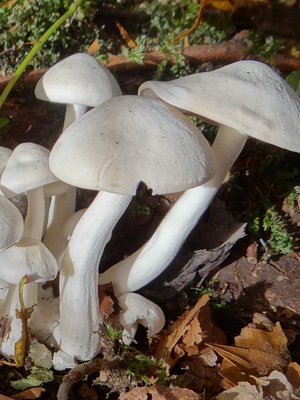
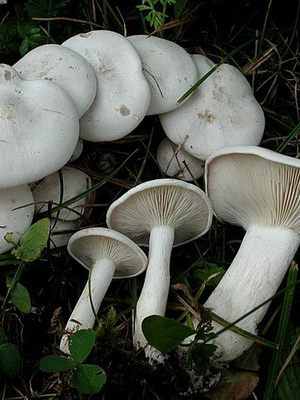
Cap: reaches a diameter of 3 cm to 10, and sometimes 15 cm. Young mushrooms have a convex cap shape, then a flat-convex one. The surface is smooth and dry, velvety to the touch, white. During the rains, it takes on a bluish or gray-olive tint. The edges of the cap are turned down, and in older specimens they become wavy.
Leg: length from 4 cm to 12 cm, thickness from 0.5 cm to 2 cm. Has a flattened or cylindrical shape, velvety to the touch. The structure is fibrous, becomes hollow with age, but the white color remains unchanged throughout the growth of the fungus. The fused bases of the legs form a semblance of a common root.
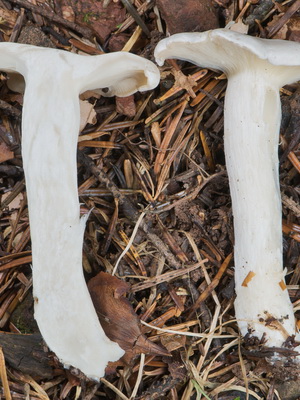
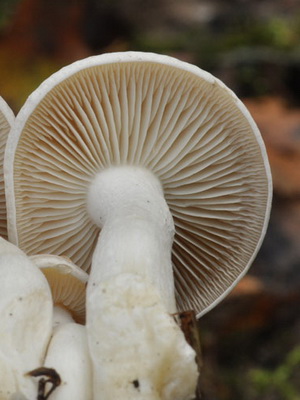
Flesh: elastic, white, with a cucumber-like scent.
Plates: the mushroom ryadovka accrete is a plate-like species with moderately frequent plates, which weakly descend on the stem or grow widely to it. In young mushrooms, the plates are white or light cream, in adults they become pale yellow.
Spores: white, smooth, elliptical.
Application: fused rows have immunostimulating effects and have the ability to inhibit the development of tumors.
Edible: it is considered an edible mushroom, but recently it has been classified as a conditionally edible species. However, there are no cases of poisoning caused by a fused rowing.
Distribution: grows in forests of various types from late August to October. It can often be found along forest paths, in illuminated areas of the forest. Fruiting in intergrown bunches of up to 20 specimens of different sizes.
Similarities and differences: the characteristic way of fruiting a row is difficult to confuse with other types of mushrooms. Other types of porcini mushrooms do not form such aggregates at the roots. However, they can be confused with edible accrete mushrooms - colibia, as well as marble honeydew, which causes brown rot of the tree.
False doubles
The grown row is easy to confuse with other species of this family, if it is not enough to study. The danger is that you can accidentally stumble upon a poisonous mushroom, but mistake it for edible. To do this, you need to study the twins and compare the differences from the photo.
The main difference between the inedible fruit is a foul smell and an attractive curved cap. Consider the dangerous doubles of the row in the table.
| Name | The form | Color | Smell, taste |
White row |
Round-convex hat, dry | White, but turns yellow over time with brown spots | Musty smell, bitter, pungent taste |
Spruce row |
Small hat with a recess, round, thick curved leg | Brown | Unpleasant |
Soap row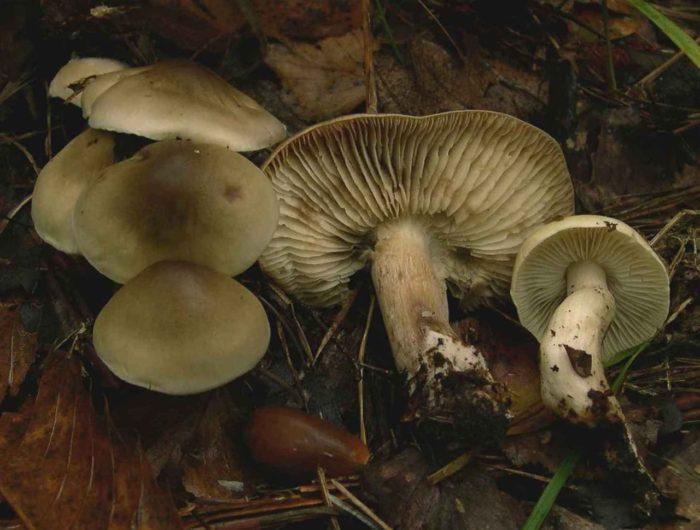 |
The hat is smooth, conical. | Olive color of the cap, lighter at the edges. | Fruity, soap-like odor, unpleasant taste |
Stinking ryadovka |
Convex head shape, curved leg | White with brown spots | Smells like gas, bitter taste |
Evaluation of taste, medicinal properties, benefits and possible harm
- Experienced mushroom pickers say that the taste of the rowers is rich and pleasant, but there are those who do not share this position. Still, the mushroom contains vitamins and has a number of beneficial properties: antiviral, antioxidant, anti-inflammatory.
- In medicine, row enzymes are used to create antibiotics against tuberculosis. The mushroom also helps with diabetes and hypertension, fatigue, weak brain activity.
- The substances contained in edible mushrooms have a beneficial effect on the entire human body and help the immune system to cope with diseases.
- The grown ryadovka is a low-calorie mushroom, but in terms of the composition of chemical elements it is similar to meat and can become its substitute in food. Because of this, it is consumed by vegetarians and recommended by nutritionists.
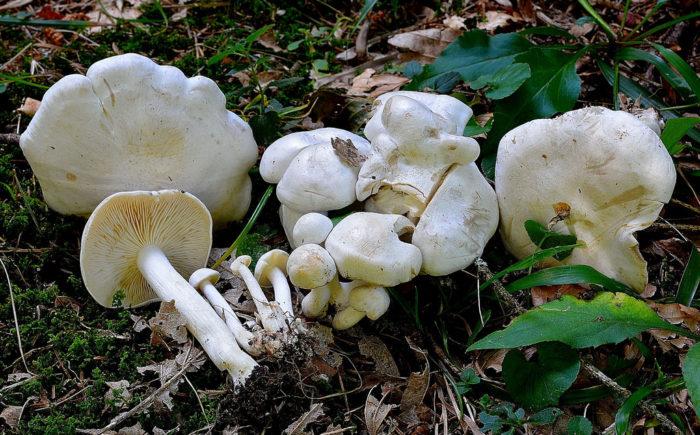
How to boil, marinate and pickle
In order to cook ryadovki, a simple recipe is used: pour 1 liter of water into a saucepan, add 30 grams of salt, a pinch of citric acid (to reveal the taste) and wait for it to boil. Add fruit bodies, stir and cook for 20 minutes, gradually adding seasonings. Suitable for rows: allspice, bay leaves, cloves. At the end of cooking, drain the water and continue cooking in another way, for example, marinate.
A container is prepared for marinating the row. This is usually a glass jar with an iron lid, which is used to pickle vegetables for the winter. Having doused with boiling water, boiled mushrooms are poured into it and a teaspoon of vinegar, the same amount of sugar, 6 black peppercorns, cloves and bay leaves are added. Then you need to cover the container with a lid and roll it up for the winter. In a closed jar, blanks are stored until next fall, and after opening for only a week.
For the winter, you can salt the row.Preparing again and pouring boiling water over the jar, put horseradish, 10 peppercorns and mushrooms on top, salt each new layer. Add garlic and roll up the jar. In a month and a half, the rows will be ready for serving.
Toxicity
The accreted ryadovka is usually considered an edible mushroom, but nowadays it is often ranked among inedible and even poisonous species. Cases of poisoning caused by the fungus are unknown. In 1984, the aliphatic azoxy compound lyophyllin, contained in it in a significant amount, was isolated from the fungus, presumably (due to the similar structure with elayomycin and methylazoxymethanol) capable of having a mutagenic and carcinogenic effect. Also in 1984, a hydroxyurea derivative N-hydroxy-N ', N'-dimethylurea, possibly an inhibitor of DNA synthesis, was discovered in mushrooms. These substances are not destroyed by heat treatment.
Definitioner
- Basidia (Basidia)
-
Lat. Basidia. A specialized structure of sexual reproduction in fungi, inherent only in Basidiomycetes. Basidia are terminal (end) elements of hyphae of various shapes and sizes, on which spores develop exogenously (outside).
Basidia are diverse in structure and method of attachment to hyphae.
According to the position relative to the axis of the hypha, to which they are attached, three types of basidia are distinguished:
Apical basidia are formed from the terminal cell of the hypha and are located parallel to its axis.
Pleurobasidia are formed from lateral processes and are located perpendicular to the axis of the hypha, which continues to grow and can form new processes with basidia.
Subasidia are formed from a lateral process, turned perpendicular to the axis of the hypha, which, after the formation of one basidium, stops its growth.
Based on morphology:
Holobasidia - unicellular basidia, not divided by septa (see Fig. A, D.).
Phragmobasidia are divided by transverse or vertical septa, usually into four cells (see Fig. B, C).
By type of development:
Heterobasidia consists of two parts - hypobasidia and epibasidia developing from it, with or without partitions (see Fig. C, B) (see Fig. D).
Homobasidia is not divided into hypo- and epibasidia and in all cases is considered holobasidia (Fig. A).
Basidia is the place of karyogamy, meiosis and the formation of basidiospores. Homobasidia, as a rule, is not functionally divided, and meiosis follows karyogamy in it. However, basidia can be divided into probasidia - the site of karyogamy and metabasidia - the site of meiosis. Probasidium is often a dormant spore, for example in rust fungi. In such cases, probazidia grows with metabasidia, in which meiosis occurs and on which basidiospores are formed (see Fig. E).

See Karyogamy, Meiosis, Gifa.
- Pileipellis
-
Lat. Pileipellis, skin - differentiated surface layer of the cap of agaricoid basidiomycetes. The structure of the skin in most cases differs from the inner flesh of the cap and may have a different structure. The structural features of pileipellis are often used as diagnostic features in descriptions of fungi species.
According to their structure, they are divided into four main types: cutis, trichoderma, hymeniderma and epithelium.
See Agaricoid fungi, Basidiomycete, Cutis, Trichoderma, Gimeniderm, Epithelium.
- Pileipellis (Pileipellis)
-
Lat. Pileipellis, skin - differentiated surface layer of the cap of agaricoid basidiomycetes. The structure of the skin in most cases differs from the inner flesh of the cap and may have a different structure. The structural features of pileipellis are often used as diagnostic features in descriptions of fungi species.
According to their structure, they are divided into four main types: cutis, trichoderma, hymeniderma and epithelium.
See Agaricoid fungi, Basidiomycete, Cutis, Trichoderma, Gimeniderm, Epithelium.
- Cutis
-
The type of cap skin, consists of creeping non-gelatinized hyphae located parallel to the surface. The surface of the cap looks smooth.
Lat. Cutis.
See Gifa.
Growing at home and in the country
The methods of cultivating crowded rows are similar to the methods of growing mushrooms, but this process will still require certain skills. Features of the cultivation of lyophyllum:
- The room temperature should be 15 ° C.
- The most optimal time for breeding rows is May, but autumn is also quite suitable.
- In the summer cottage, the mushroom is grown in the beds, which should be covered with a film from the scorching sun and precipitation.
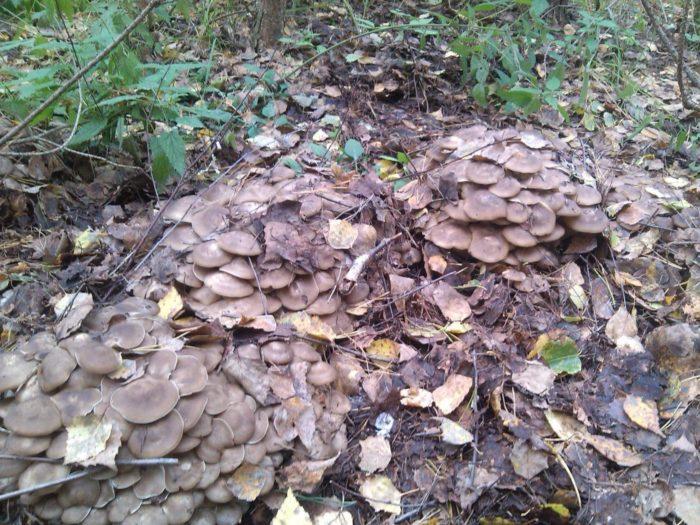
To grow rows in the country, you need to do the following:
- Mix the substrate with mycelium in a 1: 2 ratio, cover with foil to ensure high humidity.
- After 2-3 weeks, cover the culture with a 5 cm layer of moist soil.
- In a month, the first fruiting bodies will appear on the surface of the soil.
- After each harvest, it is necessary to make an additional layer of soil of half a centimeter.
- As soon as the temperature drops below 5 ° C, cover the ground with mycelium with a cloth, and lay a layer of leaves or straw at least 10 cm on top.
How to breed rows indoors:
- Maintain the room at a constant temperature of 10-15 ° C, optimal humidity, good ventilation and lighting.
- If all conditions are met, the first fruiting bodies will appear on the surface of the soil in 3-4 weeks.
- You need to carefully harvest and sprinkle the soil with a new layer.






